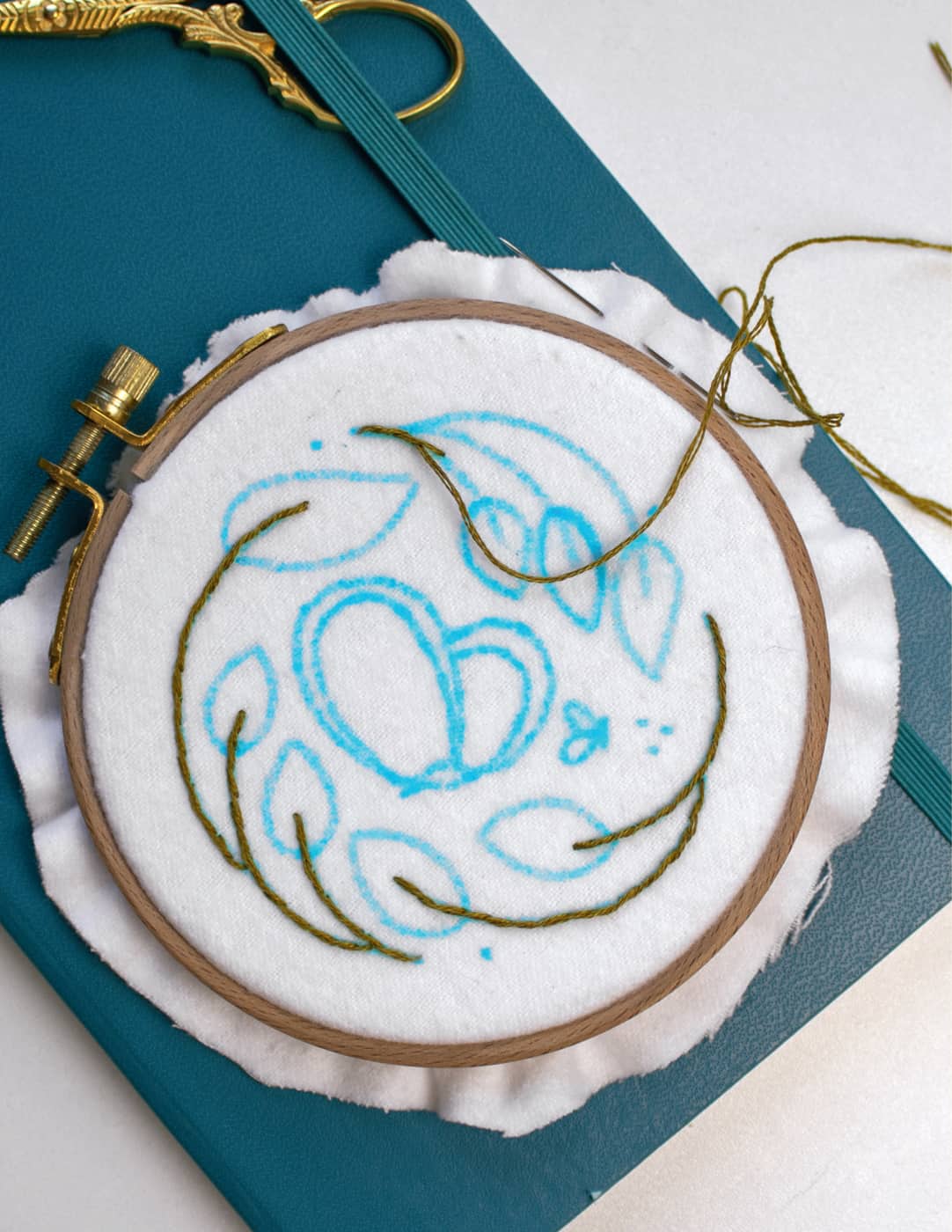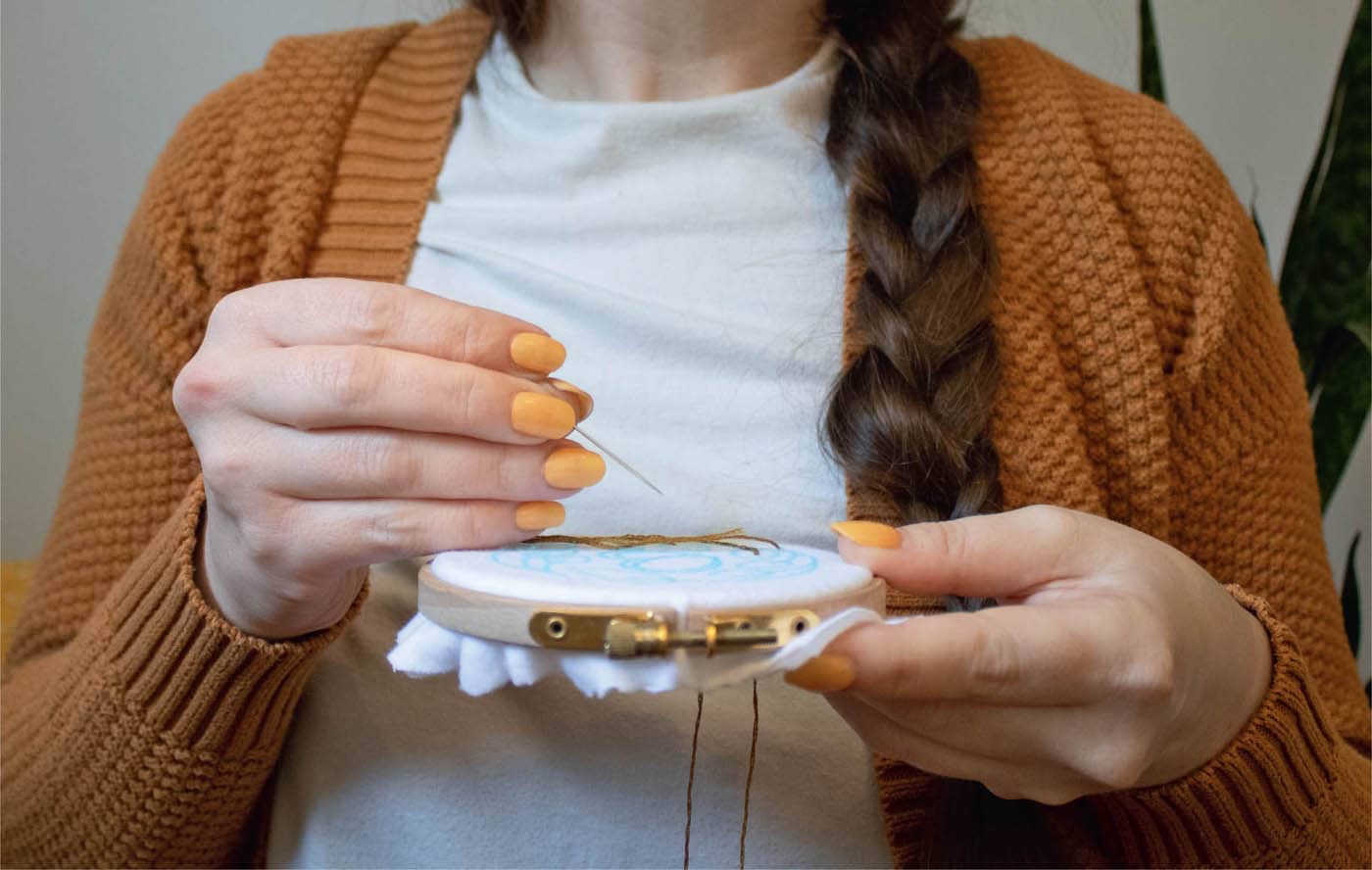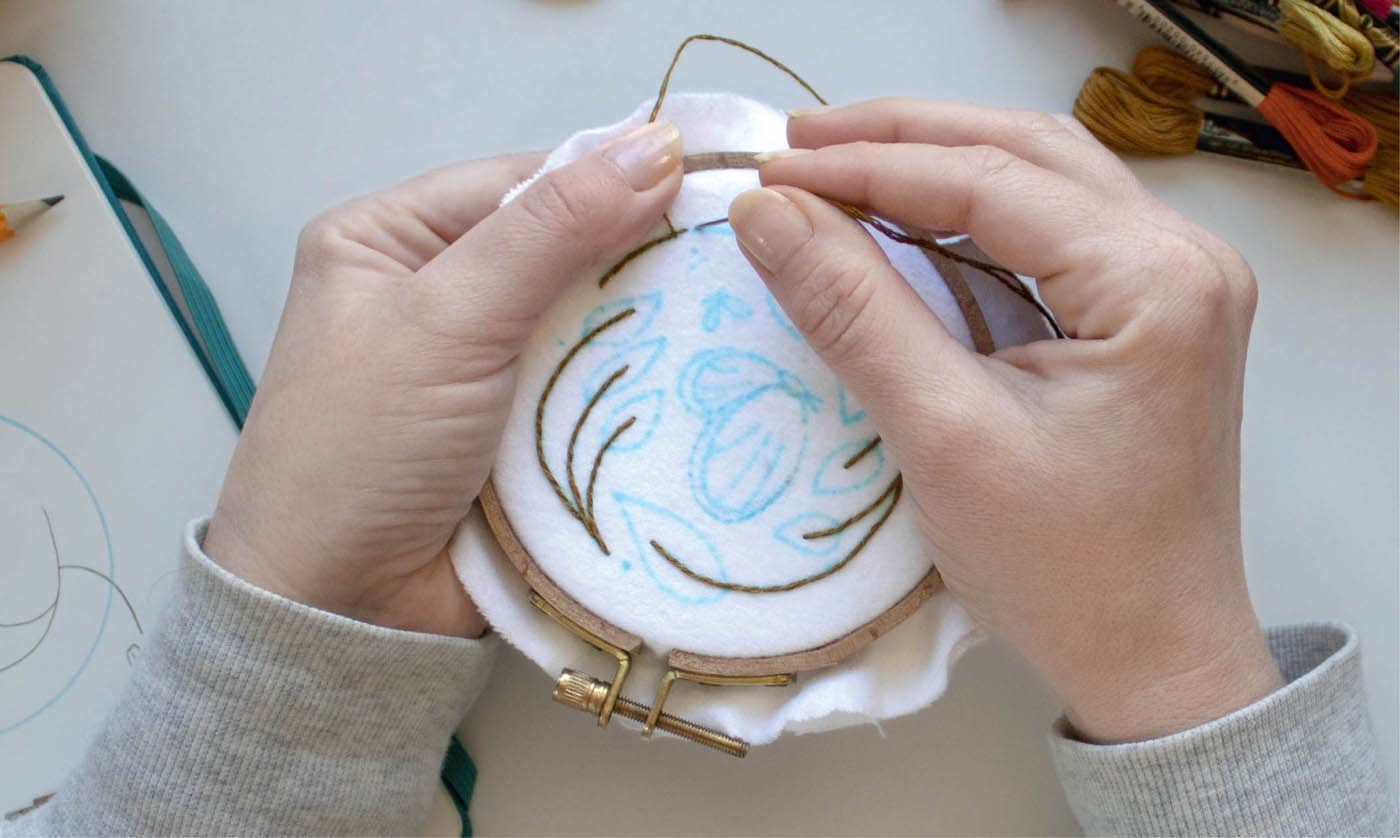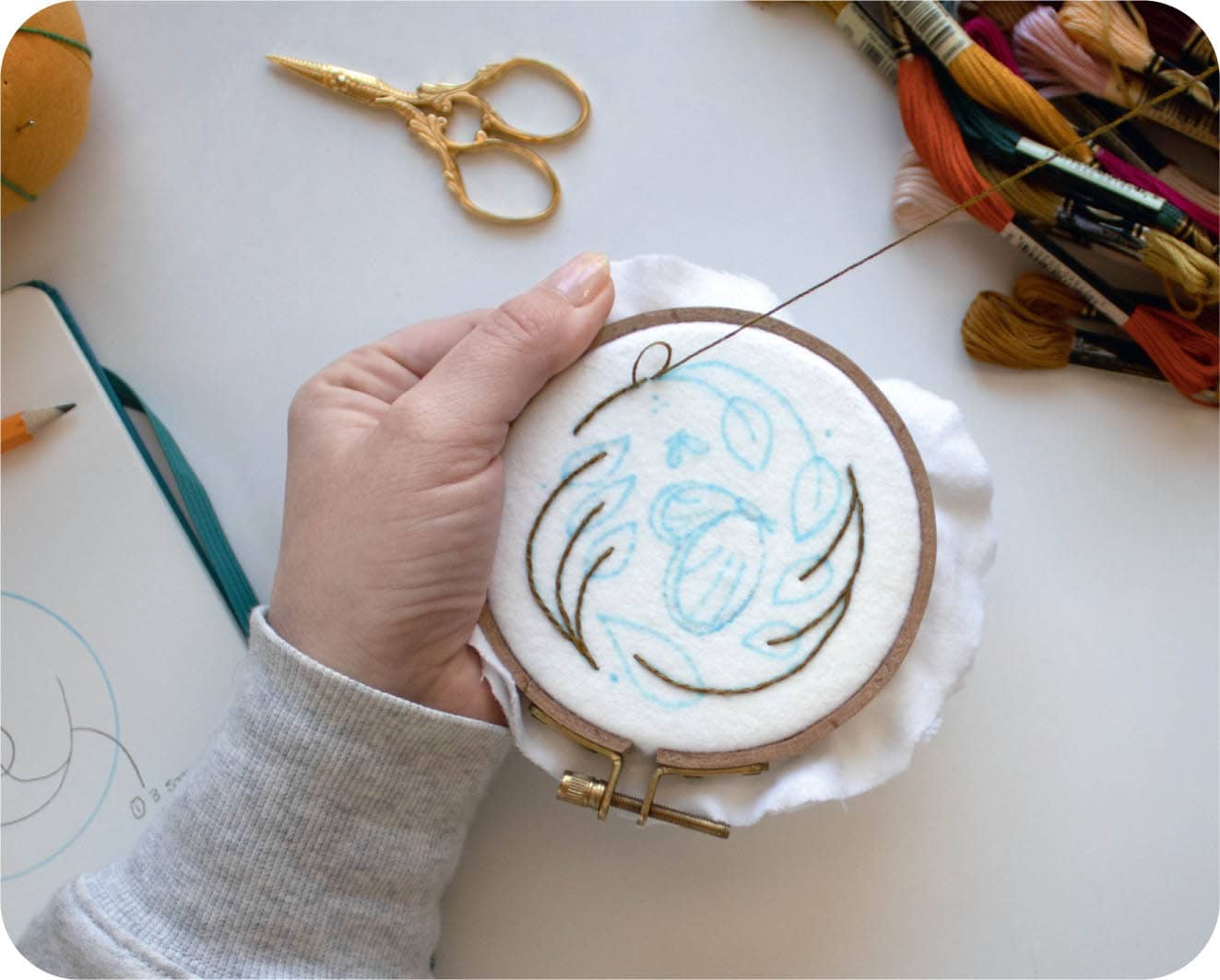

I understand this misconception. I am also a person who exists in a world where we are constantly bombarded with pseudoscientific sales schemes and promises of a happier life if we would just pick up this new craft, buy this new product, or listen to this particular teacher. While writing this book, searching for “mindful” within the “Crafts, Hobbies & Home” subsection of Amazon Books reveals over 10,000 results; and within the “Needlecrafts & Textile Crafts” subsubsection, where my chosen craft of hand embroidery lives, there are nearly 300 results. Surely, hand embroidery must be mindful! And if it’s not, I must be intimating that it can’t improve your mental health, because again— mindfulness and mental health are one in the same, right? Not necessarily.
My background in mindfulness dates back to 2007 when I began my training to receive a master’s in Applied Psychology. In 2009, I would start a five-year-long process of attempting a PhD in Clinical Psychology, but I later dropped out of that program before finishing. A portion of my training, both in my completed master’s and incompleted PhD, included using mindfulness within the context of individual and group psychotherapy to help clients dealing with a variety of concerns, such as anxiety, depression, eating disorders, substance-use disorders, and even personality disorders and partner abuse.
Psychotherapy techniques that incorporate mindfulness-based strategies and techniques have been popularized by the likes of Jon Kabat-Zinn, Marsha Linehan, and Steven Hayes, who borrowed a portion of the concept of mindfulness from the Buddhist religion. Mindfulness within the context of psychotherapy can include everything from a standardized weeks-long intervention, such as Kabat-Zinn’s Mindfulness Based Cognitive Therapy (MBCT), to shorter exercises within the context of other programs, such as Linehan’s Dialectical Behavioral Therapy (DBT) or Hayes’ Acceptance and Commitment Therapy (ACT), both of which have mindfulness components. These mindfulness-heavy interventions and the concept of mindfulness itself have been so well-popularized that they have made their way into the pop consciousness, included in the titles of our coloring books, cookbooks, and hand-embroidery books.
You may have tried mindfulness in the past, either as part of a religious practice, therapy, or through self-help books and mindfulness-friendly crafts (such as cross stitch, crochet, or diamond painting), and found it to be helpful to your overall mental health. Alternatively, you may have tried mindfulness and found that it didn’t work for you, in which case you might have had a similar experience to me! Just like any therapeutic intervention or stress-relief activity, one size does not fit all, and mindfulness did not fit me. In fact, researchers have found that mindfulness as a therapeutic intervention is contraindicated for certain individuals, meaning that it not only doesn’t help us, but in some cases, it can be detrimental to our overall well-being.
Why does all of this matter? First, it’s important to understand that “mindfulness” is not a synonym for mental health but rather a specific technique that can be used for some people, in some contexts, toward a general goal of a happier, more contented internal life. It’s also important to understand that the mindfulness we see in self-help books is borrowed from the mindfulness developed in research-based therapies, which itself is borrowed from the mindfulness practiced in Buddhism. This is important to understand because often, when we’re introduced to a concept such as “mindfulness” within the self-help arena and it doesn’t work for us, researchers have found that we might be less likely to seek out additional help or resources. Finally, given that so many people without the background and experience necessary to provide that sort of instruction are nevertheless using it to sell their craft, it’s important for me to let you know that I do not consider hand embroidery—at least, not the way I teach and practice the art, myself—to be a mindfulness-based craft.
All that said, I don’t want you to think that because hand embroidery isn’t necessarily mindful, you can’t get any mental health benefits out of learning and loving the craft. In fact, if you’ve attempted to approach this craft in the past hoping for a mindful result but felt frustrated with yourself in the process, I would encourage you to give yourself a chance to think about hand embroidery in a new, perhaps more nuanced way.
I started to learn embroidery at a very difficult time in my life where I felt like an imperfect quitter who couldn’t afford to be artsy and would never get good enough at something to be considered great. When I first picked up embroidery, I had just left a PhD program and began working as a barista making minimum wage. I didn’t know where my life was headed, felt like I had spent my 20s working toward a singular goal that was now out of reach, and was struggling to make basic ends meet. In between shifts, I would occasionally scroll through sites like Pinterest and Etsy, finding myself wishing I had something to talk about other than being a sad, anxious failure. I needed a hobby.
Eventually, I reached under my bed for the few craft supplies I had accumulated while still in school, specifically cross stitching fabric, embroidery floss, and a plastic hoop I didn’t understand how to use. Unlike freehand embroidery, cross stitchers usually use an evenly woven fabric (such as aida) to create designs using multiple cross stitches to fill in a charted image. Cross stitching allows you to create beautiful, intricate designs, and I love and admire the work of cross stitchers and designers to this day. I, however, could not do it. Looking back, it’s possible my inability to get into cross stitching had something to do with the innate “mindfulness” of the task itself; again, therapeutic mindfulness does not work for me and can sometimes leave me feeling worse than before.
At some point, I decided to learn how to do a few simple embroidery stitches. I needed a more hand-embroidery–friendly fabric but couldn’t afford any new supplies. Luckily, hand embroidery allows you to stitch on any sort of fabric you can find, so I switched out the cross-stitch fabric for an old fabric shower-curtain liner in my linen closet. I followed a few tutorials and used the friendship bracelet floss I had from my existing cross-stitch supplies to finish a simple sampler. That experience—finding the supplies that worked best for my budget and goals, slowly learning how to do a few simple stitches, and finishing something—was transformative. I posted that first finished project to social media, very proudly (and a bit self-deprecatingly) letting my friends and family know that I could totally finish something.
I continued to use the fabric from that shower curtain, cutting it into small pieces for new projects, and collecting bits of additional supplies here and there. Each new finished project filled me with a strange sense of relief and hope, and I found myself reciting certain phrases to myself as I stitched:
This hoop isn’t perfect, and that’s okay. It’s not supposed to be perfect—it’s handmade.
I don’t want to finish this project I’ve spent hours on already, and that’s okay because it’s healthy to move on to something better suited for me.
I don’t have a whole lot of supplies or skills. Let me see what I can make from my own point of view and within my own financial constraints.
What’s more, these repeated phrases and lessons began to spill into other areas of my life. Eventually, I found myself using hand embroidery as a tool to help me actively “correct” some of the not-so-great thoughts and feelings I was dealing with on a daily basis. I started a process of accepting my imperfections, embracing letting go of goals that were no longer serving me, and working within my constraints rather than hiding in shame.
In psychology, this is sometimes referred to as a “corrective emotional experience,” meaning, an experience that allows you to see yourself or a situation in a new, more emotionally fulfilling or productive way. You might have had similar experiences through therapy that taught you how to be kind to yourself after a difficult childhood, through relationships that taught you that it’s possible to trust again, or through meaningful work that taught you to feel needed and competent. Similarly, embroidery taught me that it’s okay to be imperfect, that it can be healthy to move onto something new, and that it’s okay if I’m starting with fewer resources or knowledge than somebody else. That said, although embroidery has indeed helped me by serving as a sort of “corrective emotional experience,” it hasn’t necessarily “fixed” anything. It’s simply one tool, of many, that I’ve found to be helpful.
It’s possible you’ll have a similar experience with hand embroidery as I have, but it’s also okay if you don’t. Whether embroidery turns out to be an emotionally transformative experience for you, a hobby you simply enjoy doing in and of itself, or even a craft you try once or twice before deciding it’s not for you—I hope the approach I use to teach my favorite craft is helpful to you in your journey.


Hand Embroidery Is Not Supposed to Be Perfect
Embroidery isn’t supposed to be perfect—it’s handmade! When you finish a project, you’ll have created something unique to you, a family heirloom to be treasured because of its flaws—not in spite of them.
As I designed and stitched the projects for this book, I noticed this coming up again and again, catching myself being overly critical of my own work and wondering if anybody would take me seriously if I messed up a stitch or chose the wrong color. Rather than letting those thoughts overtake me or criticizing myself for still dealing with those thoughts in the first place, I used these moments of doubt as an excuse and reminder to actively practice taking my own advice: namely, to remember that hand embroidery is not supposed to be perfect and that the projects would work themselves out in the end.
You Don’t Have to Finish Every Project You Start
It’s absolutely okay to put your unfinished projects in an “unfinished projects” box and move on to something more fun, more interesting, or more approachable to you. The process can still be rewarding, even if you never finish the project itself.
What you see in this book are projects that I finished. What you don’t see are all the projects that didn’t work out—maybe the design was off, maybe the design was great but I needed to restitch with a new color palette, or maybe the colors were gorgeous but towards the end of stitching I realized the design wasn’t interesting enough for me to finish. Those unfinished projects weren’t a waste of time; rather, they taught me something about what I do or don’t want to stitch, how to trust my gut in terms of color and composition, and ultimately helped me to finish the projects I did finish and eventually included in this book. When I do find myself needing to scrap a project and start over, I put the unfinished piece in a box or basket devoted to things I didn’t complete. Later, I’ll look through them and reflect on what they taught me about what I like or don’t like, what I enjoy making, and the projects that I did finish after letting go of the ones that didn’t work.
There Are No “Best” Embroidery Supplies
There are no best supplies, just like there’s no “best” embroidery artist. Embroidery can be a very cheap hobby to get into—use whatever supplies work best for your budget.
When I first got into embroidery, I could only afford a few simple and cheap supplies myself. I bought inexpensive, off-brand floss meant for “friendship bracelet” crafts and used an old shower-curtain liner as fabric. In fact, I incorporate cheaper floss and thrifted fabric into my work to this day. That said, you will notice that I’ve stitched the projects in this book using DMC Cotton Embroidery Floss. I chose to be consistent with the brand of floss I used to help you re-create the projects with those exact colors, should that be your preference. If picking out similar colors from a more financially or geographically accessible brand of floss works better for you, I would absolutely encourage you to do that! Sometimes, when stitching personal projects using some combination of well-known floss brands and cheaper, friendship-bracelet floss, I’ll find myself wondering if people will notice that I used not-so-great supplies when I show them my finished work. Guess what? They never notice. I hope this encourages you to use whatever works best for you, even if you’re unable to use specific supplies along the way.
You Don’t Need to Learn Every Single Stitch or Technique
I recommend that newer stitchers focus on learning the stitches you need for a particular project, building your skills from there. Let the projects you want to create be your guide in terms of which stitches you choose to learn; otherwise, you might start to feel a little overwhelmed.
I certainly don’t know how to do every single stitch in hand embroidery—there are hundreds and hundreds of different stitches! I learned the stitches I do know by creating things, slowly adding new stitches to my repertoire as I created more and more pieces. If you work through a few projects in this book and decide that you’re really only interested in doing one stitch for your own future designs and projects, that would be absolutely in line with how lots of different artists approach their work. Learn what feels right for you and try not to worry about learning every single stitch or technique.
Similarly, the stitches and techniques you’ll see later on in this book were chosen because they were what I ended up using for the projects themselves. To this day, I still let the projects I’m working on and what I want those to look like determine which techniques I’ll learn and use to complete a project.
If Something Looks “Off” or “Bad,” Consider Asking Yourself a Series of Simple Questions
As you stitch, you may find that something feels “off,” even if you’ve made some progress toward accepting imperfections in general. In these situations, I think it’s helpful to ask yourself a series of simple questions meant to guide you toward figuring out what’s going on for you and your project.
First, does it actually look “bad,” or are you placing unreasonable expectations on yourself? As with any other medium, your hand embroidery will get better over time, and it would be silly to expect yourself to be at a certain level when you’ve only just begun to learn and practice!
Second, have you given yourself some time away from the project? Often, after hours of stitching, it’s hard to see the project as a whole. Giving yourself some space—whether that’s a night of sleep, a weekend, or as long a time as you need—can help you to see the project with a more discerning, and perhaps forgiving, eye. You might also consider taking a few photos of your work, which I find helps me evaluate projects from a fresh perspective.
Third, are you comparing yourself to somebody else? It is so easy to get caught in the comparison trap when working on such a shareable, popular craft as hand embroidery. Often, when we think to ourselves that our project doesn’t look so great, what we’re really thinking is, “it’s not as good as this other person’s work.” Focusing on our own progress and work is difficult, but it beats comparing ourselves to others to the point that we decide to quit altogether.
Fourth, could it be worth reaching out to a friend for feedback? Sharing work with a trusted friend, even if they’re not an embroidery artist themselves, can help us to figure out what is or isn’t working. Often, it serves as the validation we need to cut out a few stitches and start over or to trust the process and keep going in the same direction.
Finally, is there something technical getting in the way? At times, you’ll find yourself sure that something isn’t quite right, and no amount of sleep or validation or talking yourself out of it can convince you otherwise. If that’s the case, it could be that you’re still developing the skills and practice necessary to figure out certain technical issues that might get in the way of a great result. For example, it could be that your fabric is not tight enough in your hoop. As you’ll learn later on in the book, having tight fabric makes stitching so much easier by providing you with a nice, clean, taut background for your stitching. Another technical issue could be the hoop itself. You may find that the project looks better if framed in a different color of hoop or in a frame meant specifically for embroidery. More often than not, a simple restitch with fewer (or more) strands of floss will do the trick. Again, this sort of technical troubleshooting comes with practice and can be aided by taking time away from your project, collecting feedback from trusted friends, and slowly gaining the skills necessary to make decisions about your work as you go.

